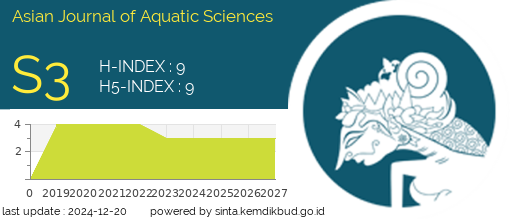ISOLATION AND IDENTIFICATION OF MICROPLASTIC DEGRADING BACTERIA IN THE APHOTIC ZONE IN BAGANSIAPIAPI WATERS, RIAU
DOI:
https://doi.org/10.31258/ajoas.8.2.193-202Keywords:
Microplastics, Degrading Bacteria, Aphotic Zone, Stutzerimonas stutzeriAbstract
This study aims to isolate and identify microplastic-degrading bacteria from the aphotic zone in Bagansiapiapi waters, Riau Province. Seawater samples were taken from three different stations, namely the port area, the fisheries area, and the Rokan River estuary. Water quality parameters such as temperature, salinity, pH, current speed, brightness, and dissolved oxygen were measured to support environmental analysis. The method used in this study was a survey method, and the sampling location was around the Bagansiapiapi waters, Riau Province. A total of 9 samples were then taken to the laboratory for isolation and identification of microplastic-degrading bacteria. Bacterial isolation was carried out using Zobell Marine Agar media, morphological characterization and biochemical tests. The isolation results obtained 11 bacterial isolates with different morphological characteristics. The microplastic degradation test showed that three isolates, namely ISL1, ISL3, and ISL9, could degrade microplastics, with ISL1 showing a degradation percentage of 9.45%. Molecular analysis using 16S rRNA and BLAST techniques showed that the ISL1 isolate had a similarity of 99.93% with Stutzerimonas stutzeri. These results indicate the potential of native bacteria from the aphotic zone to be used in bioremediation efforts for microplastic pollution in waters
Downloads
References
1. Vianti, R.O., & Purwiyanto, A.I. Purifikasi dan Uji Degradasi Bakteri Mikroplastik dari Perairan Muara Sungai Musi, Sumatera Selatan. Maspari Journal: Marine Science Research, 2020; 12(2): 29-36.
2. Seftianingrum, B., Hidayati, I., & Zummah, A. Identifikasi Mikroplastik pada Air, Sedimen dan Ikan Nila (Oreochromis niloticus) di Sungai Porong, Kabupaten Sidoarjo, Jawa Timur. Jurnal Jeumpa, 2023; 10(1): 68–82.
3. Cordova, M.R., Purwiyanto, A.I.S., & Suteja, Y. Abundance and Characteristics of Microplastics in The Northern Coastal Waters of Surabaya, Indonesia. Marine Pollution Bulletin, 2019; 142: 183–188.
4. Mardalisa, M., Fatwa, E.B., Yoswaty, D., Feliatra, F., Effendi, I., & Amin, B. Isolasi dan Identifikasi Bakteri Indigenous Pendegradasi Plastik dari Perairan Laut Dumai Provinsi Riau. Jurnal Ilmu Perairan (Aquatic Science), 2021; 9(1): 77– 85.
5. Sila, N., Birawida, A.B., & Natsir, M.F. Keberadaan Bakteri Pengurai Bahan Pencemar Organik pada Air Limbah Domestik Pulau Kodingareng. Jurnal Nasional Ilmu Kesehatan, 2022; 4(3): 44-51.
6. Putri, R.R., Widyorini, N., & Jati, O.E. Analisis Perbedaan Kelimpahan Bakteri Heterotrof dengan Kandungan Bahan Organik pada Sedimen di Ekosistem Mangrove Trimulyo, Kecamatan Genuk, Kota Semarang. Jurnal Pasir Laut, 2021; 5(1): 32-39.
7. Hursepuny, J.J., Moniharapon, T., & Mailoa, M.M. Karakteristik Kimia dan Mikrobiologi Bakasang Jeroan Ikan Tuna Sirip Kuning (Thunnus albacares). INASUA: Jurnal Teknologi Hasil Perikanan, 2021; 1(2): 86-99.
8. Bacha, A.U.R., Nabi, I., & Zhang, L. Mekanisme dan Pendekatan Rekayasa untuk Degradasi Mikroplastik. ACS Environ. Sci. Technol. Eng. 2021; 1: 1481–1501.
9. Afianti, N.F., Febrianti, F.K., Hatmanti, A., Endrotjahyo, E., Manik, H., & Sutiknowati, L.I. Identification and Screening of Biofilm-Forming Bacteria Isolated from Mangrove Sediment for Plastic Degradation. Journal of Ecological Engineering, 2024; 25(8).
10. Howard, S.A., Carr, C.M., Sbahtu, H.I., Onwukwe, U., López, M.J., Dobson, A.D., & McCarthy, R.R. Enrichment of Native Plastic‐associated Biofilm Communities to Enhance Polyester Degrading Activity. Environmental Microbiology, 2023; 25(12): 2698-2718.
11. Yang, G., Quan, X., Shou, D., Guo, X., Ouyang, D., & Zhuang, L. New Insights into Microbial Degradation of Polyethylene Microplastic and Potential Polyethylene-Degrading Bacteria in Sediments of The Pearl River Estuary, South China. Journal of Hazardous Materials, 2025; 486:137061
Downloads
Published
Issue
Section
License
Copyright (c) 2025 Sutan Bachar, Feliatra Feliatra, Nursyirwani Nursyirwani (Author)

This work is licensed under a Creative Commons Attribution 4.0 International License.







